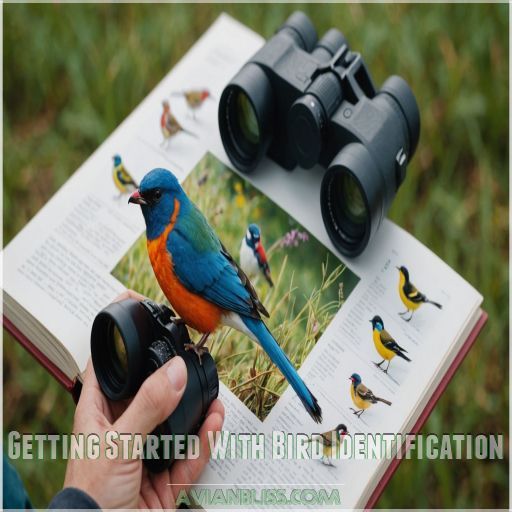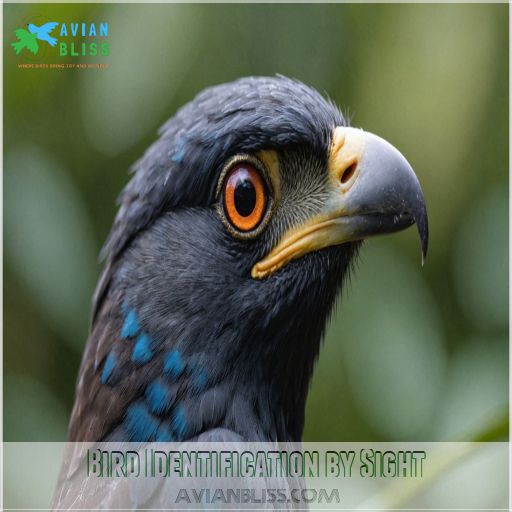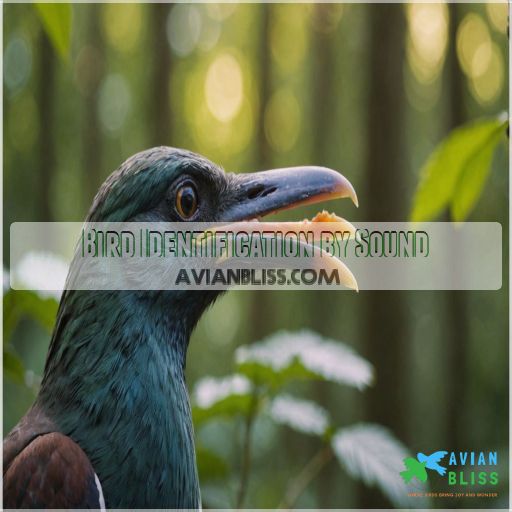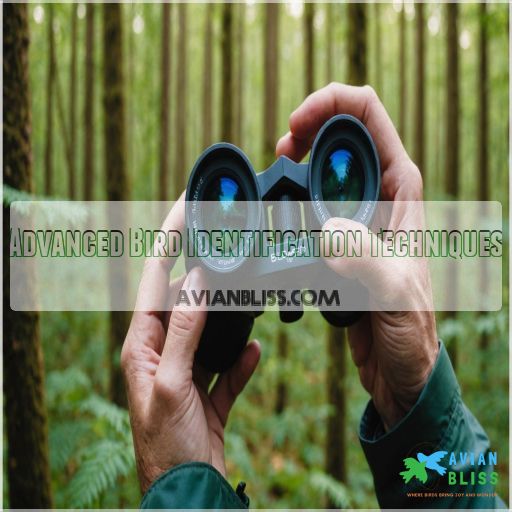This site is supported by our readers. We may earn a commission, at no cost to you, if you purchase through links.

Then, observe birds closely to spot their unique shapes, sizes, feathers, and behaviors. Don’t forget to listen for their songs and calls too.
Advanced techniques like identifying blackbirds by their distinctive calls, such as the "chuck" or "chirp" call of the Yellow-headed Blackbird Pennsylvania blackbirds or by their nests can take your skills to the next level
. The key is regular practice and connecting with experienced birders.
Soon, you’ll be a pro at spotting and naming your local avian neighbors. Ready to take your birding to new heights? Let’s get started!
Table Of Contents
- Key Takeaways
- Getting Started With Bird Identification
- Bird Identification by Sight
- Bird Identification by Sound
- Advanced Bird Identification Techniques
- Improving Your Bird Identification Skills
- Frequently Asked Questions (FAQs)
- What is the best website to identify birds?
- Can I upload a picture of a bird to identify it?
- How do I find out what kind of bird this is?
- Is there a totally free bird identification app?
- How do weather conditions affect bird behavior?
- What are common mistakes in bird identification?
- How can I attract diverse birds to my yard?
- What apps are best for bird identification?
- How do seasonal changes impact bird activity?
- Conclusion
Key Takeaways
- Get the Right Gear: You’ll need a pair of good binoculars and a trusty birding app like Merlin Bird ID. Think of these as your magnifying glass and notebook, essential for solving the mystery of each bird you encounter.
- Observe and Listen: Pay attention not just to shape and color, but to behaviors and calls. It’s like tuning into a secret bird show, where every chirp and flutter holds a clue.
- Practice Regularly: Just like practicing a musical instrument, bird identification gets easier with time and dedication. Head out often, and slowly turn those big feathered puzzles into familiar friends.
- Connect with Others: Join local birding clubs or meetups – they’re like birdwatching parties where you swap stories and tips. Plus, it’s more fun hunting with a flock than flying solo!
Getting Started With Bird Identification
When you’re starting with bird identification, get yourself a decent pair of binoculars and a reliable birding field guide to spot those feathered friends more easily
.
It’s like a treasure hunt where you’re the detective, piecing together clues from their shapes, colors, and calls.
Essential Tools for Bird Identification
When you start bird identification, a good pair of binoculars and a trusty field guide are must-haves, with essential gear that includes a field notebook and comfortable clothing.
Use birdwatching apps like Merlin ID for quick help with bird songs and photos.
These tools, combined with listening to bird calls and observing behavior, will turn you into a skilled bird detective in no time.
Choosing the Right Birding Gear
Getting into birding feels like starting a colorful adventure. Equip yourself wisely to capture those feathered wonders.
- Binoculars – Essential for close encounters with elusive species.
- Field Guides – Handy books keep your bird ID skills sharp.
- Backpack – Carry essentials comfortably during your treks.
Now go spot your next life list entry!
Downloading Bird Identification Apps
Selecting the perfect binoculars?
Now, supercharge your bird-watching with apps like Merlin Bird ID or Audubon Bird Guide.
These tools offer features such as sound and photo ID, helping with bird identification at your fingertips. While most are free, some may lack precision for raptor identification.
It’s a pocket-sized birder’s best friend!
Bird Identification by Sight
Spotting birds by sight is a thrilling challenge where you match distinctive beak shapes and vivid plumage to names, just like piecing together a feathered puzzle.
You might feel like a bird detective, trying to decode the quick darting movements of a Blue Jay or the bold colors of a Northern Cardinal right in your backyard.
Recognizing Bird Shapes and Sizes
So, you’ve got your gear and apps ready—let’s tackle bird shapes and sizes.
Picture a mystery bird: notice its silhouette, compare its wingspan, and check body proportions, beak size, and tail length.
Falcons, chickadees, juncos, swallows, and swifts each have unique identities. Master these, and birding becomes as easy as pie—or at least more rewarding!
Identifying Bird Feathers and Plumage
Your feathers hold the key to understanding the secrets of your feathered friends. Look closely at the patterns, colors, and structures to identify different species.
For example, examining the feather’s basic structure, including the calamus, rachis, and barbs, can help you better understand the unique characteristics of each species.
From the iridescent blue of a magpie’s wing to the barred brown of a woodcock, each feather tells a unique story, with features like bird feather identification guides helping you decipher the details.
Mastering feather identification will open up a whole new world of birdwatching.
Noticing Beak Shapes and Leg Colors
With a keen eye, spot beak shape adaptations and leg color variations in birds.
Beaks can hint at evolutionary significance and bird diet clues—like pliers, they pick the perfect meal! Meanwhile, leg colors serve as handy habitat indicators.
Remember, this isn’t just for the birds; it’s a window into nature’s wonders! Now, go feather your wisdom!
Observing Bird Behaviors and Habits
Imagine you’re a detective in the bird world.
To truly uncover their secrets, watch how they feed, nest, and migrate. Observe territorial displays and social interactions like it’s a nature soap opera.
Birds aren’t just tweeting about breakfast; they’re revealing clues about their habitats and behaviors.
So grab your binoculars and let the feathered drama unfold! (Source)
Using Field Guides for Bird Identification
When you’re learning bird identification, choosing the right field guide is really important.
Decide between digital vs. print, weighing convenience against tradition.
Look for guides using illustrations, as they often highlight key features better than photos.
Explore field guide apps for easy access on your phone.
Quick tip: study your guide at home; in the field, birds won’t wait!
Bird Identification by Sound
Picture yourself sipping coffee on a quiet morning when you realize that identifying birds isn’t just about seeing them; it’s about listening, too.
By learning their songs and calls, you’ll discover new ways to recognize your feathered friends, even when they’re hidden in the leaves, and develop a deeper understanding of your surroundings through the art of listening.
Learning Bird Songs and Calls
You’re honing your birding skills by sight, but let’s tune into the world of sound.
Identifying bird songs offers a symphony of bird call variations to explore, especially when studying the names of sounds of birds
.
Try Merlin or BirdNET apps for tackling bird song identification challenges, and marvel at mimicry in birdsong.
It’s an evolutionary jazz session, not always straightforward, but infinitely rewarding.
Recognizing Bird Sounds in Different Environments
Ever tried tuning into bird sounds amidst urban noise, forest calls, or wetland acoustics? It’s like finding a needle in a haystack.
In urban jungles, chirps compete with honking horns. Meanwhile, forest calls echo mysteriously through dense woods, and wetland acoustics transform songs into symphonies.
Birds’ surroundings significantly affect their songs, and by learning to recognize these environments through bird habitat identification, you can refine your identification skills. Each habitat impacts how bird sounds travel and mix, crafting nature’s unique playlist.
Using Audio Guides for Bird Identification
Harness the power of audio guides to identify birds by their songs, such as those of the Black-capped Chickadee, and impress your friends with your newfound birding prowess backyard birds of Maine
.
Apps like Merlin Bird ID tap into vast databases, offering real-time suggestions as you record the feathered serenades around you.
With a little practice, you’ll be decoding the dawn chorus and adding to your life list.
Double-Add to Your Life List.
Identifying Birds by Their Vocalizations
To identify birds by their songs, a good starting point is to focus on common backyard visitors, paying attention to pitch, rhythm, and repetition in their vocalizations, and utilizing a bird songs and calls guide. How do you identify birds when only their songs serenade your ears? Listen closely!
Bird vocalizations, like catchy tunes, reveal identities with unique calls and regional variations.
By practicing, you’ll even detect mimicry—nature’s delightful impressionists.
Use apps to hone this skill, as each bird has a story to tell through its song, inviting curiosity and discovery.
Advanced Bird Identification Techniques
Think you’re ready to level up your birding skills?
With advanced techniques like spotting birds in flight and recognizing young ones, you’ll soon be the Sherlock Holmes of the bird world.
Unraveling nature’s mysteries with each feathered friend you encounter is a skill that will take your birding to new heights, making you a true expert in the field of bird world, especially when considering the best weather for bird watching optimal birding conditions
.
Identifying Birds in Flight
Bird calls echoed in your mind, now watch them soar. Identifying birds in flight requires keen observation. Notice their grace and the science behind their flight.
Look for:
- Flight patterns – rhythmic or erratic?
- Wing shape – broad like a hawk or narrow like a swift?
- Silhouette – sleek or chunky?
- Tail shape – forked or fan-like?
Your skills will take off!
Recognizing Juvenile and Immature Birds
Spotting young birds can feel like cracking a complex code.
Juvenile plumage often disguises identity, but molt patterns reveal age-related variations through careful observation.
Be on the lookout for awkward movements or subtle color differences.
Observing the behavior of birds in their natural habitat, such as their unique social dynamics and collective intelligence through flocking behavior patterns, can be fascinating. Patience is key—sometimes an adult bird swoops in for identification backup.
Embrace these bird identification challenges and soon, you’ll master this avian mystery.
Identifying Birds by Their Nests and Eggs
Stumble upon a mysterious nest? It’s a page from nature’s diary!
Learn its secrets with keen observation of:
- Nest Materials: Is it crafted from mud, feathers, or twigs?
- Egg Patterns: Examine size and color variations.
- Nest Location: Perch high or ground-bound?
- Breeding Season: Is it prime nesting time?
Enjoy this egg-citing mystery!
Using Bird Identification Charts and Diagrams
Switching from nests and eggs, you’ll find bird identification charts are invaluable in the field.
They’re like the cheat sheet you never knew you needed. These charts offer diagram types that highlight key features, though remember, no chart’s perfect.
Use them wisely, embrace their limitations, and let each colorful diagram spark your curiosity.
Bird Identification Apps and Software
Discover the power of bird identification apps like Merlin, eBird, and the Audubon Bird Guide.
These digital tools offer instant bird IDs, customizable checklists, and a wealth of information on over 800 species.
Snap a photo, record a call, or answer a few questions – these apps will have you identifying birds like a pro in no time with their customizable checklists.
Local Birding Clubs and Meetups
While bird identification apps offer handy digital assistance, joining local birding clubs adds a human touch to your birdwatching journey.
Connect with local experts, enjoy club events, and participate in field trips—all while honing advanced skills and practicing birdwatching etiquette.
Membership benefits include access to rare sightings and the camaraderie of like-minded enthusiasts.
| Benefit | Description | Example Activities |
|---|---|---|
| Birdwatching Etiquette | Learn proper behavior | Group workshops |
| Club Events | Social gatherings | Monthly meetings |
| Field Trips | Explore together | Habitat visits |
| Membership Benefits | Exclusive perks | Access to experts |
Bird Identification Books and Field Guides
Joining a birding club is fantastic, but you’ll also need trusty field guides for detailed study. Choose guides wisely to capture the nuances of your regional birds.
- Best Beginner Guides: The Kaufman Field Guide.
- Regional Guides: The Crossley ID Guide: Eastern Birds.
- Online Resources: Audubon Bird Guide app.
- Using Field Guides: Practice regularly to sharpen your skills.
Improving Your Bird Identification Skills
Sharpening your bird identification skills is all about practice, persistence, and a dash of patience.
By regularly observing birds, keeping a life list, and learning from seasoned birders, you’ll soon be wowing your friends with your newfound expertise.
While maybe even out-birding your neighborhood know-it-all, this will be a result of your newfound expertise.
Practicing Bird Identification Regularly
Honing your birding skills requires regular practice, much like perfecting a musical instrument. Face birdwatching challenges head-on by using local birding groups and relish in bird identification quizzes.
Keep a bird journal to track your progress. Compare notes on identifying similar species—it’s an avian mystery waiting to be solved!
| Activity | Benefit | Tools Needed |
|---|---|---|
| Birdwatching challenges | Enhance skills | Binoculars |
| Bird identification quiz | Test knowledge | Smartphone |
| Keeping a bird journal | Track observations | Notebook and pen |
Keeping a Life List of Identified Birds
Imagine your life list as a tapestry weaving memories of rare bird sightings and birdwatching challenges.
Each entry tells a story, enhancing your skills and bringing joy.
Organize with purpose and set list goals to track birds seen.
Share your list with fellow enthusiasts. It’s not just numbers; it’s a thrilling adventure, connecting you to nature’s wonders.
Learning From Experienced Birders
Get started with birdwatching by learning from the pros!
Chat with experienced birders for expert identification and birdwatching tips on how to sneak up
.
Join local birding groups to swap tales and lessons.
Use their field guide recommendations to enhance your skills. It’s like getting a cheat sheet in a treasure!
You’ll learn birdwatching ethics while having fun discovering feathered wonders.
Frequently Asked Questions (FAQs)
What is the best website to identify birds?
Bird watching’s a breeze with the free "Merlin Bird ID" app.
The app is buzzing with billions of bird data entries from eBird.
Snap a pic or describe features, and discover your feathered friends effortlessly.
Can I upload a picture of a bird to identify it?
You can indeed upload a picture to identify a bird.
Try using the Merlin Bird ID app, which offers a Photo ID feature that works offline, helping you pinpoint the bird in your photos.
How do I find out what kind of bird this is?
Snap a photo of the bird and use an app like Merlin Bird ID.
It suggests matches based on your photo and even identifies songs.
It’s like having a bird expert in your back pocket.
Is there a totally free bird identification app?
Did you know Merlin Bird ID, from Cornell Lab, uses eBird’s four billion global observations to help you identify birds for free?
It’s like having a feathered encyclopedia in your pocket, perfect for curious bird lovers everywhere.
How do weather conditions affect bird behavior?
Weather can turn bird behavior on its head.
Birds hunker during storms, migrate with temperature drops, and adjust flying patterns due to wind.
It’s like they listen to nature’s radio station, tuning in daily for the latest updates.
What are common mistakes in bird identification?
Misidentifying birds is common, but you can avoid it.
Pay close attention to key field marks, double-check with guides, and don’t be afraid to say "I’m not sure."
With practice, you’ll become a pro at bird ID.
How can I attract diverse birds to my yard?
Attract diverse birds by mixing up feeders, food types, and heights.
Add a bubbling birdbath and plant native shrubs for shelter.
A dash of humor? Sure, it’s like hosting a buffet with free parking! (Source).
What apps are best for bird identification?
Merlin Bird ID is tops for birding with sound and photo ID features, plus it’s free.
Audubon Birds and eBird apps also shine with their real-time IDs and bird checklists, suitable for rookies and pros alike (Source).
How do seasonal changes impact bird activity?
As seasons shift, birds adapt their activities based on daylight length.
You’ll see migrations in spring and autumn, with different species appearing or departing.
While changing temperatures and food availability tweak their daily rhythms and behaviors .
Conclusion
Mastering bird identification is like becoming the Sherlock Holmes of the avian world!
With the right tools and practice, you’ll soon decode the mysteries of bird shapes, songs, and behaviors.
Each encounter is an opportunity to sharpen your skills and add a new species to your life list.
Don’t be shy about joining local birding groups—they’re a great way to learn and share.
So grab your bird identification guide and begin a winged detective adventure!








